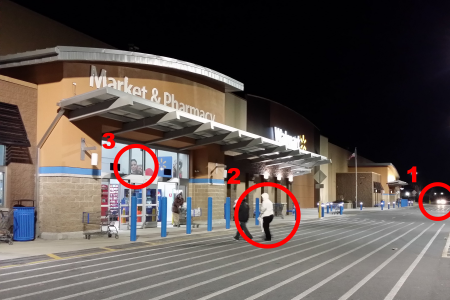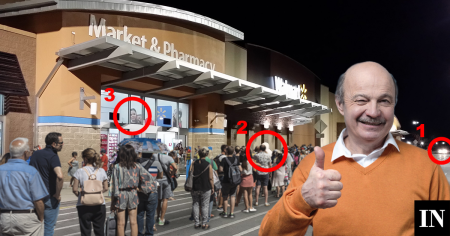Educating people about copyright…
12 minute read
February 27, 2023, 1:24 PM
Sometimes it’s interesting what happens when you discuss copyright infringement amongst your friends. I recently made a post on Facebook about a company that routinely uses my photos in their work, that I have not had any success in pursuing. It led to very positive discussion, and I think that I helped a few folks learn something new about intellectual property that they may not have known before.
Unlike most occasions when I will go online and grouse about unauthorized usages of my photography, this one turned up some new discussion besides the standard responses like, “You should sue them,” and the like. For the record, while taking someone to court over copyright infringement is definitely a possible remedy, it is by no means the only remedy, nor is it something that one takes lightly. This is not a case of, “When all you have is a hammer, everything starts to look like a nail.” A lawsuit is really only a viable option in a small subset of usage cases, and while there have been lawsuits filed on my behalf regarding unauthorized usages, they are exceedingly rare. Also, note “filed on my behalf” in that last sentence. I do not file lawsuits myself. People that I have designated as my agents who know more about these things than I do are the ones who file the suits. I know my own limits. Also, people forget that the instances of copyright infringement that I grouse about online are just the ones that really irk me, and also are ones that got away. Most of my copyright infringement cases are resolved amicably, and you never hear about those.
A few points came up in this discussion that are worth mentioning here. First was a suggestion that I watermark my images. This is a perennial suggestion, and, truth be told, it’s something that I’ve tested and implemented in the past, and later had to undo. Back in the early 2000s, I started some early forays into photo licensing, under a brand called “StratoSearch”. When I was getting ready to implement that, I started putting watermarks on my photos on Schumin Web in order to prevent clean copies of the larger photos from going out willy-nilly, i.e. reserve the clean versions for paying clients. With that, I put Schumin Web’s logo in the corner of the full-size images, i.e. the ones that you click through to see. That was a bit of extra work on my part, but I did it, using a template to apply the logo. I eventually dropped the licensing effort there after a rebranding and redesign in 2003 failed to drum up any business. I now understand that my work back then was not to the level of quality that I thought it was, and that my marketing efforts were terrible. But nonetheless, the watermarks remained. If you want to see what the watermark looked like in practice, go look on College Life, where the watermark has been retained, and where there are no plans to remove it for historical reasons.
Starting in 2005, I made a deliberate effort to move away from watermarking images. That was when I started participating on Wikipedia, and working with their free-content model. Watermarks were incompatible with a free-content model, and I was releasing photos under that sort of licensing scheme on their platform. Schumin Web eventually was switched to Creative Commons in its entirety, and that was the case until mid-February 2014 (so anything published after that point was never available under Creative Commons). With that in mind, I started working to eliminate watermarks on my site, because that was inconsistent with the free-content philosophy, since that got in the way of downstream usages. Plus Wikipedia was getting clean images there, so it’s not like the clean versions weren’t already floating around. I want to say that the watermarks were initially dropped for new works going forward, and then they were later retroactively removed as far back as 2005 (a change in how I organized photo set masters was made starting with the A16 photo set, which enabled it that far back, but not any further back without significantly more work). They weren’t removed entirely until the site was converted to WordPress in 2012, and I created new publication masters for all of my older images, reprocessing them from the originals.
And then of course, there’s my other reason for eliminating watermarking from the website: they are ugly. I’ve never seen a watermark on an image that looks good, no matter how hard the person tried. Someone also suggested that I should embed authorship information into the metadata of the photos that I publish. That was something that I had tested a while back, but ultimately decided not to roll out on a larger scale as part of my regular workflow, because it was too much extra effort and was too easily stripped back out, defeating the purpose.
Another thing that someone brought up in this discussion was a common myth about copyright. They said this:
I don’t get what the big deal is considering the picture. Also how did they get it? You put it out there somewhere.
Another friend responded before I did, saying this:
This argument comes up a lot for photography but not for any other medium. I’d ask what J.K. Rowling’s response should be if someone claimed that they wrote the Harry Potter series. Not a big deal since the books were put out in stores and libraries, right?
They put it so well, that all I could do was agree:
Well said. That sort of argument also defeats the purpose of having copyright in the first place.
The person was then surprised that my photos were copyrighted, not realizing the way that copyright works. I explained:
Yes, anything is automatically copyrighted from the moment that it is made, including this Facebook comment.
They responded with “OK”, which makes me hopeful that I taught them something, i.e. they are now a slightly more learned person than they were before our discussion. But yes, copyright is automatic these days. It’s not something that you have to actively seek out in order to achieve. One can certainly still register works with the federal government, which confers certain additional benefits, but it’s not required to simply be protected by copyright.
Another person made a comment on a separate thread that said, “They should give credit.” I quickly responded, “They should ask permission, not just give credit after the fact. Credit without permission is just advertising who you stole from.” The photo that was the subject of the original discussion was a post-2014 image, which meant that Creative Commons, which does seek to make usage in exchange for attribution legal, did not apply in that situation. Therefore, in that situation, a byline was merely advertising who the photo was stolen from, and did not serve as a way of making it legal. It’s amazing how many people think that providing credit magically makes it okay. It also amuses me how often I see things like “Credit to the photographer” and similar as a byline on various websites and social media posts. To me, that says, “I’m stealing this and being blatant about it, and I don’t care enough to bother researching who this even came from, but if it was you, consider yourself credited.” The people that do that are the kind of lazy bums where I make my authorship known to them via a DMCA takedown notice, and take great pleasure in submitting them in those instances. I don’t ask those people to comply in a nice way. I demand it via established legal processes.
Then the best part of the discussion was when a friend asked a question of how I am able to identify my own photographs when it came to common subjects:
Not trying to be an asshole – that could be a pic that anyone took. Is there something that identifies it was your photo specifically?
I really enjoyed answering this question, because people are always surprised about what I’m looking for when I’m identifying a specific photo. I’m not looking at the subject of the photo specifically, but rather, I’m looking at very small details, at a very “micro” level. I’m looking at the way small details line up with other details in the shot – things that would be different between individual shots taken at the same time, let alone between different photographers. I learned this a decade or so ago when I was doing all of the photo restoration work as part of the WordPress conversion, and had to differentiate between multiple similar photos taken at the same time in order to locate the exact shot that was used when the photo set was initially designed. After all, my goal in reprocessing all of the photos was not to fundmentally change the photo sets – just to shine them up a bit while bringing them up to newer design standards.
Let me provide two examples of what I mean. First, here’s an example of shot-to-shot differences, using a photo from 2019 that I published on Flickr:

This is the published shot, showing a Blue Line train at Foggy Bottom.

This is an alternate shot taken three seconds prior.
The two shots largely look identical, and the average person viewing these photos would likely not recognize right offhand that these are, in fact, two separate shots that are not identical. When I’m looking to determine which photo is which, I’m really not looking at the train at all. That didn’t move between shots, as evidenced by the fact that the doors are open in both photos. Rather, I’m looking at background elements, such as the people on the platform near the far end of the train. I’m also looking at how various elements interact with the edge of the photo. To tell these two photos apart, I looked at four elements:
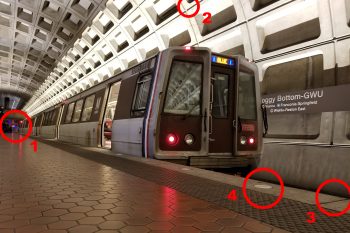
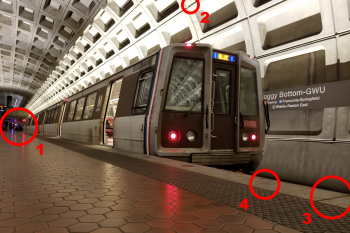
(Published shot on left, alternate on right)
The first element that I looked at was the people, marked “1”. Here they are, close up:
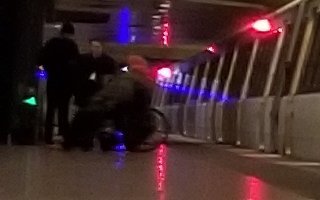

(Published shot on left, alternate on right)
Note that the person in the wheelchair is further away from the train in the published shot than in the alternate, and the man in the center overlaps with the man on the left in the published shot, while there is space between them in the alternate. People are usually an easy way to tell two photos apart, because people are living beings and don’t tend to hold the exact same position for very long. People are generally in different positions between shots taken moments apart, even if the difference is subtle (except for the person visible through the door on the train – they didn’t move at all between shots).
The next element that I looked at here, marked “2”, is the way that the coffer in the ceiling interacts with the frame. In the published shot, you can see the corner of the coffer, and the shadow within it. In the alternate shot, only the very edge of that same coffer is visible. That tells me that the published shot is at a slightly higher angle than the alternate. In other words, the camera moved slightly between shots (this was a handheld photo that I took with my relatively lightweight phone, so such movement is inevitable). Similarly, the element marked “3” is another frame interaction. The joint between the two granite slabs on the platform edge hits the frame differently. In the published photo, there is a slight space between the joint and the edge of the photo. In the alternate, the joint touches the frame.
Then the final element, marked “4”, is a gimme that’s easy to miss (even I missed it on first glance). Note the platform edge lighting. For those not familiar, the platform edge lighting begins to flash when a train is arriving in the station, and continues to flash until the train has departed the station. The lighting is on in the published shot, but it is off in the alternate. I typically try to get my shots with the platform lights on, but it doesn’t always work out that way.
So that’s one example of how I identify my own photos, comparing two similar shots. I have the photo that I am trying to match as a control, and then I start comparing elements to determine which photo matches. This is typically how I do internal matching, where I’m digging around in my own archive in order to turn up a specific shot.
The same principle holds when I find a match in the field, and I’m verifying that something is, in fact, my photo. I find the photo that I think it is, and then I start comparing elements. I always verify carefully, because there are sometimes instances where I’ve been fooled, i.e. I find something that looks very similar to my own work, but nonetheless is not my work. A few shots from the 7000-Series preview event are like this, as a few other people got some shots at similar angles to mine, and I have to start looking at reflections and tree branches and such in order to ensure that it’s my shot.
Here’s an example from the field, using a photo that I published in early 2014 of the Walmart on Chesapeake Center Drive in Glen Burnie, Maryland:

Published photo of the Walmart in Glen Burnie.

Modified version of the same photo, done by a downstream user.
First of all, before anyone pulls out their pitchforks, this usage was legal, at least as far as my interest in the photo is concerned. This was a Creative Commons-licensed image, and they followed the terms completely (I picked out an authorized usage for this example on purpose). Unfortunately, though, while I saved it as an example of a downstream usage of my work at the time that I found it, I wasn’t able to locate it again when it came time to write this entry. I don’t know if it went offline or whatever else, but nonetheless, if this was you, or if you know the article that this was attached to, please let me know so that I can provide a link to it.
In any case, the downstream user took my basic photo and added a whole bunch of other elements to it in order to illustrate their article. They added a row of people standing outside, and they also added the gentleman giving the thumbs up, as well as a mark in the corner. I admit that I laughed a little bit when I saw this photo, because the people that were added by the downstream user are obviously dressed for warmer weather, while the original photo was taken in January, on an extremely cold night.
But identification of the photo is the same as with the Metro example. So let’s mark it up:
The first element, marked “1”, is the presence of a car with headlights on in the right side of the photo. This is something that would be different between individual shots (though in this case, I only took one shot at this location), and if someone else were to shoot in the same location under similar conditions, the car would most likely not be there. It matches, therefore we have a winner there. I could stop there, but there are other elements to consider. The next one, marked “2”, concerns two people walking in my original photo. In the second photo, the person wearing dark clothes is completely obscured by the added crowds, but the person in the white hoodie is visible amongst the crowd. They wouldn’t appear in someone else’s shot. And then the last one, marked “3”, is a lineup issue. Note the way that the graphics of the people on the wall in the vestibule line up with the leftmost metal column on the entrance frame. If this were taken at a slightly different angle, the graphics and the column would not interact the same way. It’s the same in both images, therefore we have a match.
There are other elements that we could match as well, such as the lady with the shopping cart exiting the store or the shadows on the wall lighting, but I believe that you get my point. That’s how I verify matches and make sure that they are what I think that they are. Then in photos taken in other conditions, I match other things. One thing that I typically lock onto is clouds. Despite what it looks like sometimes, clouds are not static by any means. Remember that Journal entry that I wrote where I discussed the changes in a cloud over a few minutes? There you go. Clouds are usually different between shots of the same subject when taken at the same time, and will certainly be different between photographers. You want to talk about looking at clouds and seeing things in them and all, but you will become an expert at it when you’re judging photos based on clouds.
So there you have it, I suppose. I love a positive discussion about copyright where people learn something from it. And, of course, if we’re talking about copyright, make sure to give Brad Templeton’s “10 Big Myths about copyright explained” article a read if you have not done so already, because it explains a lot and does it very well.
Categories: Copyright infringement, Social media










